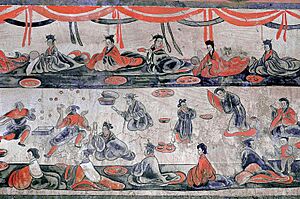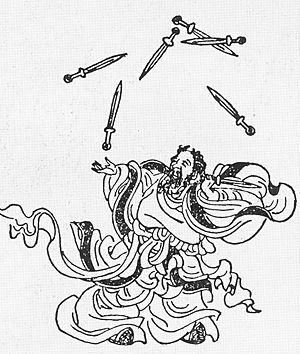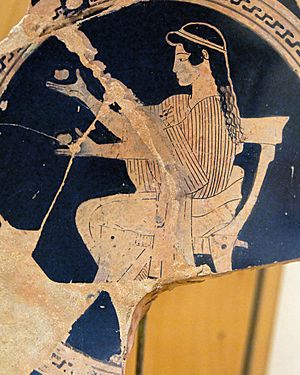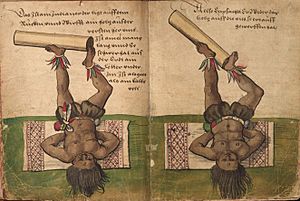History of juggling facts for kids
The art of juggling has been around for a very long time, in many different cultures. No one knows exactly when it started. The first pictures of juggling were found in ancient Egypt, China, Greece, and Rome. It also appeared in medieval times and continues to be popular today.
Contents
Juggling in Ancient Egypt
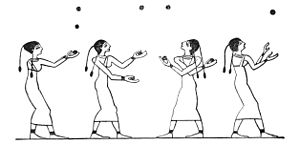
The oldest known record of toss juggling is a painting on a tomb wall in Egypt. This tomb, called Tomb 15, is in the Beni Hasan cemetery. It belonged to a governor named Baqet III. The painting shows women dancers and acrobats juggling up to three balls. One girl is even juggling with her arms crossed!
Another painting in Beni Hasan shows four girls playing a juggling game. Two girls throw and catch a ball while being carried on the backs of the others. One idea is that if a player dropped the ball, it was their turn to carry someone else.
Some experts think that jugglers in these tombs might represent something deeper. They believe the balls could be like mirrors or round objects that stood for the sun, birth, and death.
Juggling in Ancient China
Ancient Chinese writings show that juggling was a well-developed art form. This was especially true during the Spring and Autumn period.
Xiong Yiliao: The Battle Juggler
There was a warrior named Xiong Yiliao who lived around 603 BC. He fought for the state of Chu. Ancient Chinese stories say he was very good at "throwing multiple objects up and down without dropping them."
During a battle between the states of Chu and Song, Xiong Yiliao stepped out between the armies. He juggled nine balls! The Song soldiers were so amazed that all 500 of them ran away. This allowed the Chu army to win easily. A famous book, the Zhuangzi, says: "Yiliao of Shinan juggled balls, and the conflict between the two states was ended."
Lanzi: The Sword Juggler
Another famous juggler from this time was Lanzi. He lived during the reign of Duke Yuan of Song. An ancient collection of Daoist sayings, the Liezi, tells his story:
"In the State of Song there lived a man named Lanzi, who sought favor from Lord Yuan of Song for his skills. Lord Yuan of Song summoned him, and he performed on stilts that were twice as long as his body and attached to his legs. He walked and ran on them, and he also juggled seven swords, alternately throwing them and always keeping five swords in the air. Lord Yuan was amazed, and at once he granted Lanzi gold and silk."
Lanzi juggled the `jian`, which was a straight, double-edged sword. The name "Lanzi" was often used for traveling entertainers back then.
Juggling in Ancient Greece
Jugglers were very common in ancient Greece. They were both men and women, and they often set up their shows wherever they could find people and money. They would entertain guests at parties with their tricks.
Amazing Greek Performances
Greek jugglers performed many different acts:
- They jumped forwards and backwards over swords or tables.
- Girls threw and caught many balls or hoops while music played.
- Others showed amazing skill with their feet and toes while standing on their hands.
Juggling, acrobatics, and other skill games often appear in Greek art. For example, a small clay statue from Thebes shows a man balancing balls on his knee and head. A vase from 430 BC shows a seated woman juggling two balls.
The Greek historian Xenophon wrote about a dancing girl in 421 BC. She performed at a dinner party with Socrates. Xenophon said: "And at the instant her fellow with the flute commenced a tune to keep her company, whilst someone posted at her side kept handing her the hoops till she had twelve in all. With these in her hands she fell to dancing, and the while she danced she flung the hoops into the air - overhead she sent them twirling - judging the height they must be thrown to catch them as they fell in perfect time."
Juggling in the Roman Empire
Many ancient Roman artworks show juggling. A monument in the Museum of Roman Civilization shows a man juggling five balls with his hands. He is also moving two more balls with his feet! Another carving shows a boy juggling five balls.
Roman Writers and Jugglers
Several Roman writers also mentioned jugglers. Marcus Manilius wrote about a juggler whose "quick hands supplied a constant stream of balls to his feet."
An old tombstone from the second century AD honors a juggler named Ursus. He was a "pilecrepus," which means he performed tricks by bouncing and catching a single ball with his body. His inscription says:
"Ursus, the first Roman citizen to play properly with a glass ball with my players, to the great clamoring of the approving crowd in the baths of Trojan, Agrippa and Titus and especially in the baths of Nero."
Archaeologists believe a glass ball at the Penn Museum might have been used in a juggling game called `trigon`. This game likely involved three players throwing multiple balls back and forth very quickly.
Quintilian, a Roman teacher, compared a good speaker to a juggler. He wrote that jugglers are so skilled that "one might suppose the things which they throw from them to return into their hands of their own accord."
Sidonius Apollinaris, a Roman officer, wrote that he enjoyed juggling three or four balls as a hobby. He did it for fun and to entertain his friends.
The Roman poet Martial described a juggler named Agathinus. Agathinus performed an amazing shield trick: "With swift limbs he hurls the shield up in the air and catches it on his foot, on his back, on his head and on his fingertips."
Fire and Knife Juggling
The Talmud, an ancient Jewish text, says that Rabbi Shimon ben Gamliel (who lived around 10 BC to 70 AD) could "take eight fire torches and throw them in the air and catch one and throw one and they did not touch one another."
Another mention of torch juggling comes from around 300 AD. A letter describes a woman whose husband "was attached to the Ionian lass who tosses balls and juggles torches."
An early Church leader named John Chrysostom saw jugglers in Antioch around 450 AD. He described them "tossing up knives in rapid succession into the air and catching them by the handle."
Juggling in Medieval Europe
During the Middle Ages, juggling was one of many skills performed by entertainers. You can find pictures of juggling in old books from the British Museum. One book from the 11th century shows a helper of King David juggling three balls with his right hand and three knives with his left.
William the Conqueror's minstrel, Taillefer, performed a simple juggling trick with his sword at the Battle of Hastings in 1066. He threw and caught it before fighting.
Old legends and stories also mention juggling. The Irish hero Cú Chulainn is said to have kept "nine apples, and his shield, and his sword in the air, that none of them fell to the ground."
Juggling in Other Cultures
In 1528, Babur, an emperor in India, wrote about jugglers. They could spin seven rings at the same time on their forehead, thighs, fingers, and toes! In the same year, Aztec jugglers who used their feet were brought to Europe by Hernán Cortés.
Juggling was also practiced by many Native American tribes. For example, Shoshone women played a game where they juggled up to four balls made of mud or stone. They even had races while juggling! This might be an early example of joggling (juggling while jogging).
Otedama is a traditional Japanese juggling game played by women. They throw up to five balls in a "shower pattern" while singing rhymes. A similar game called `hiko` is played by young girls in Tonga. They juggle limes or nuts in the shower pattern. The earliest record of juggling in Tonga is from 1773, describing a girl juggling five fruits on the beach. Some Polynesian women have been seen juggling as many as 7 to 10 nuts!
Modern Juggling
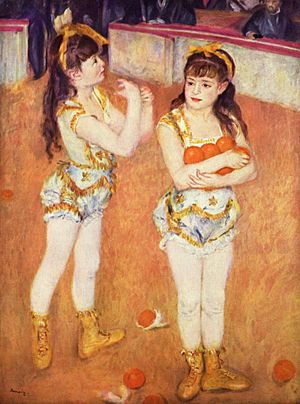
Key Moments in Modern Juggling
- 1680 – Germany: The city of Nuremberg hired a "ball-master" to juggle and teach others.
- 1768 – England: Philip Astley opened the first modern circus. He soon hired jugglers to perform alongside horses and clowns. Since then, jugglers have often been part of circuses.
- 1793 – North America: John Bill Ricketts started America's first circus. George Washington watched him juggle while riding a horse!
- 1821 – England: William Hazlitt wrote an essay about "The Indian Juggler," describing a four-ball routine. This was likely performed by Ramo Samee, who is thought to be the first modern professional juggler. He was a famous celebrity in Britain.
- Mid-Late 19th century – Europe and North America: Variety and music hall theaters became popular. Jugglers were needed to entertain audiences between music acts.
* Jugglers started to specialize, focusing only on juggling instead of other acts like sword swallowing or magic. * The "Gentleman Juggler" style became popular, with performers like Salerno and Kara. * When rubber was developed, jugglers started using rubber balls. Before this, balls were made of twine, leather, wood, or metal. Rubber balls made bounce juggling and ball spinning possible.
- 1883 – North America: A new type of variety show, later called Vaudeville, began in Boston. It featured continuous shows with many acts.
- 1885 – England: Paul Cinquevalli (1859–1918) became the first juggling superstar. The British press called him the world's greatest juggler.
- Late 19th century – Early 20th century – North America: The popularity of vaudeville shows in the USA created a huge demand for professional jugglers. They constantly invented new tricks, props, and styles to stand out.
Juggling "Firsts" in America
Here are some early juggling achievements, based on stories from the time:
- Jim Harrigan was the first "tramp juggler," using cigar boxes and balls. He was also one of the first to tell jokes during his act.
- DeWitt Cook was the first to juggle "juggling clubs." Before him, jugglers used sticks, torches, or knives. He used heavy wooden "Indian Clubs," which were shaped like bowling pins. Modern juggling clubs are based on this design.
- Charles Hoey was the first to juggle 4 clubs. He couldn't stop without dropping them, so the curtain had to close while he was still juggling!
- Ben Mowatt was the first to juggle 5 clubs.
- Pat McBann was the first to juggle six clubs. He could do 4 in one hand and 2 in the other, but he passed away before he could perform it publicly.
- John Breen juggled 7 clubs for 35 throws. He also did complex tricks like a 5-club shower and a 5-club cascade with a head balance. He performed 6 clubs on stage but died at only 21 years old in 1912.
- The first record of two people passing clubs was in 1885 by "The Murdock Bros." They passed four clubs while standing on pedestals.
- The Devine Bros were the first to pass 6 clubs while facing each other.
- The Three Mowatts were the first three-person club passing act, starting in 1895. John Whitfield from the Mowatts later formed "The Juggling Johnsons" and created the first 4 and 5-person juggling acts.
- Jack Greene and Joe Piche were the first to pass 8 clubs.
Later Developments
- 1896 – Siberia: Enrico Rastelli was born. He is considered one of the greatest jugglers ever. He was recorded juggling 10 balls (though never 9), 8 sticks, and 8 plates. He was also one of the first to use footballs (soccer balls) and other large rubber balls.
- 1912 – North America: Glow-props were invented! Adolf Behrend, a German juggler, built clubs with electric lights inside that changed colors as he juggled them.
- 1930-1950 – Europe and North America: Variety and Vaudeville shows became less popular. This was because of new entertainment like movies, radio, and television.
- 1947 – North America: The International Jugglers' Association was formed. This group helps jugglers connect and share their skills.
- 1984: Oddballs, now the world's oldest juggling shop, opened in London.


